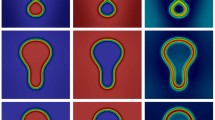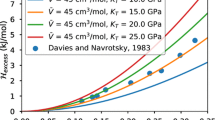Abstract
For petrological calculations, including geothermobarometry and the calculation of phase diagrams (for example, P–T petrogenetic grids and pseudosections), it is necessary to be able to express the activity–composition (a–x) relations of minerals, melt and fluid in multicomponent systems. Although the symmetric formalism—a macroscopic regular model approach to a–x relations—is an easy-to-formulate, general way of doing this, the energetic relationships are a symmetric function of composition. We allow asymmetric energetics to be accommodated via a simple extension to the symmetric formalism which turns it into a macroscopic van Laar formulation. We term this the asymmetric formalism (ASF). In the symmetric formalism, the a–x relations are specified by an interaction energy for each of the constituent binaries amongst the independent set of end members used to represent the phase. In the asymmetric formalism, there is additionally a "size parameter" for each of the end members in the independent set, with size parameter differences between end members accounting for asymmetry. In the case of fluid mixtures, for example, H2O–CO2, the volumes of the end members as a function of pressure and temperature serve as the size parameters, providing an excellent fit to the a–x relations. In the case of minerals and silicate liquid, the size parameters are empirical parameters to be determined along with the interaction energies as part of the calibration of the a–x relations. In this way, we determine the a–x relations for feldspars in the systems KAlSi3O8–NaAlSi3O8 and KAlSi3O8–NaAlSi3O8–CaAl2Si2O8, for carbonates in the system CaCO3–MgCO3, for melt in the melting relationships involving forsterite, protoenstatite and cristobalite in the system Mg2SiO4–SiO2, as well as for fluids in the system H2O–CO2. In each case the a–x relations allow the corresponding, experimentally determined phase diagrams to be reproduced faithfully. The asymmetric formalism provides a powerful and flexible way of handling a–x relations of complex phases in multicomponent systems for petrological calculations.









Similar content being viewed by others
References
Anovitz LM, Essene EJ (1987) Phase equilibria in the system CaCO3–MgCO3–FeCO3. J Petrol 28:389–414
Anderson GM, Crerar DA (1993) Thermodynamics in Geochemistry. University Press, Oxford
Aranovich LY, Newton RC (1999) Experimental determination of CO2–H2O activity–composition relations at 600–1,000 °C and 6–14 kbar by reversed decarbonation and dehydration reactions. Am Mineral 84:1319–1332
Blencoe JG, Seitz JC, Anovitz LM (1999) The CO2–H2O system II. Calculated thermodynamic mixing properties for 400 °C, 0–400 MPa. Geochim Cosmochim Acta 63:2393–2408
Bowen NL, Anderson O (1914) The binary system MgO–SiO2. Am J Sci 37:487–500
Bowen NL, Tuttle OF (1950) The system NaAlSi3O8–KAlSi3O8–H2O. J Geol 58:489–511
Carpenter MA, McConnell JDC (1984) Experimental delineation of the C1̄–I1̄ transformation in intermediate plagioclase feldspars. Am Mineral 69:112–121
Elkins LT, Grove TL (1990) Ternary feldspar experiments and thermodynamic models. Am Mineral 75:544–559
Flowers GC (1979) Correction of Holloway's (1977) adaptation of the Modified Redlich-Kwong equation of state for the calculation of the fugacities of molecular species in supercritical fluids of geological interest. Contrib Mineral Petrol 69:315–318
Fuhrman ML, Lindsley DH (1988) Ternary feldspar modeling and thermometry. Am Mineral 73:201–215
Ghiorso MS (1984) Activity/composition relations in the ternary feldspars. Contrib Mineral Petrol 87:282–296
Goldsmith JR, Newton RC (1969) P–T–X relations in the system CaCO3–MgCO3 at high temperatures and pressures. Am J Sci 267 A:160–190
Goldsmith JR, Newton RC (1974) An experimental determination of the alkali feldspar solvus. In: MacKenzie WS, Zussman J (eds) The Feldspars. University Press, Manchester
Green NL, Usdansky ST (1986) Ternary feldspar relations and feldspar thermobarometry. Am Mineral 71:1100–1108
Greig JW (1927) Liquid immiscibility in the system FeO–Fe2O3–Al2O3–SiO2. Am J Sci 14:473–484
Holland TJB, Powell R (1992) Plagioclase feldspars: activity–composition relations based upon Darken's quadratic formalism and Landau theory. Am Mineral 77:53–61
Holland TJB, Powell R (1996a) Thermodynamics of order–disorder in minerals 1: symmetric formalism applied to minerals of fixed composition. Am Mineral 81:1413–1424
Holland TJB, Powell R (1996b) Thermodynamics of order–disorder in minerals 2: symmetric formalism applied to solid solutions. Am Mineral 81:1425–1437
Holland TJB, Powell R (1998) An internally-consistent thermodynamic data set for phases of petrological interest. J Metamorph Geol 16:309–343
Holloway JR (1977) Fugacity and activity of molecular species in supercritical fluids. In: Fraser DG (ed) Thermodynamics in geology. Reidel, Dordrecht, pp 161–181
Kerrick DM, Jacobs GK (1981) A modified Redlich-Kwong equation for H2O, CO2 and H2O–CO2 mixtures at elevated pressures and temperatures. Am J Sci 281:735–767
Luth WC, Tuttle OF (1966) The alkali feldspar solvus in the system Na2O–K2O–Al2O3–SiO2–H2O. Am Mineral 51:1359–1373
Ol'shanskii YI (1951) Composition of immiscible liquids in volcanic rocks. Contrib Mineral Petrol 80:201–218
Orville PM (1963) Alkali ion exchange between vapor and feldspar phases. Am J Sci 261:201–237
Powell R (1974) A comparison of some mixing models for crystalline silicate solid solutions. Contrib Mineral Petrol 46:265–274
Powell R (1978) Equilibrium thermodynamics in petrology. Harper and Row, New York
Powell R (1987) Darken's quadratic formalism and the thermodynamics of minerals. Am Mineral 72:1–11
Powell R, Holland TJB (1988) An internally consistent dataset with uncertainties and correlations. 3. Applications to geobarometry, worked examples and a computer program. J Metamorph Geol 6:173–204
Powell R, Holland TJB (1993) On the formulation of simple mixing models for complex phases. Am Mineral 78:1174–1180
Powell R, Holland TJB, Worley B (1998) Calculating phase diagrams with THERMOCALC: methods and examples. J Metamorph Geol 16:577–588
Prausnitz JM, Lichtenthaler RN, de Azevedo EG (1986) Molecular thermodynamics of fluid-phase equilibria, 2nd edn. Prentice-Hall, Englewood Cliffs
Saxena SK, Fei Y (1988) Fluid mixtures in the C–H–O system at high pressure and temperature. Geochim Cosmochim Acta 52:505–512
Shi P, Saxena SK (1992) Thermodynamic modeling of the C–H–O–S fluid system. Am Mineral 77:1038–1049
Takenouchi S, Kennedy GC (1964) The binary system H2O–CO2 at high temperatures and pressures. Am J Sci 262:1055–1074
Thompson JB Jr, Waldbaum DR (1968a) Mixing properties of sanidine crystalline solutions. I. Calculations based on ion-exchange data. Am Mineral 53:1965–1999
Thompson JB Jr, Waldbaum DR (1968b) Analysis of the two-phase region halite-sylvite in the system NaCl–KCl. Geochim Cosmochim Acta 33:671–690
Thompson JB, Waldbaum DR (1969) Mixing properties of sanidine crystalline solutions. III: calculations based on two phase data. Am Mineral 54:811–838
Todheide K, Franck EV (1963) Das Zweiphasengebiet und die kritische Kurve im System Kohlendioxid–Wasser bis zu Drucken von 3500 bar. Zeitsch Phys Chem 37:387–401
van Laar JJ (1906) Sechs Vorträge über das Thermodynamischer Potential. Vieweg, Brunswick
White RW, Powell R, Holland TJB (2001) Calculation of partial melting equilibria in the system Na2O–CaO–K2O–FeO–MgO–Al2O3–SiO2–H2O (NCKFMASH). J Metamorph Geol 19:139–153
Wood BJ, Banno S (1973) Garnet-orthopyroxene and orthopyroxene-clinopyroxene relationships in simple and complex systems. Contrib Mineral Petrol 42:109–124
Acknowledgements
We thank Frank Spear, James Blencoe and Jamie Connolly for their valuable comments which led to improvement of the manuscript. Any errors remaining are ours.
Author information
Authors and Affiliations
Corresponding author
Additional information
Editorial responsibility: B. Collins
Rights and permissions
About this article
Cite this article
Holland, T., Powell, R. Activity–composition relations for phases in petrological calculations: an asymmetric multicomponent formulation. Contrib Mineral Petrol 145, 492–501 (2003). https://doi.org/10.1007/s00410-003-0464-z
Received:
Accepted:
Published:
Issue Date:
DOI: https://doi.org/10.1007/s00410-003-0464-z




